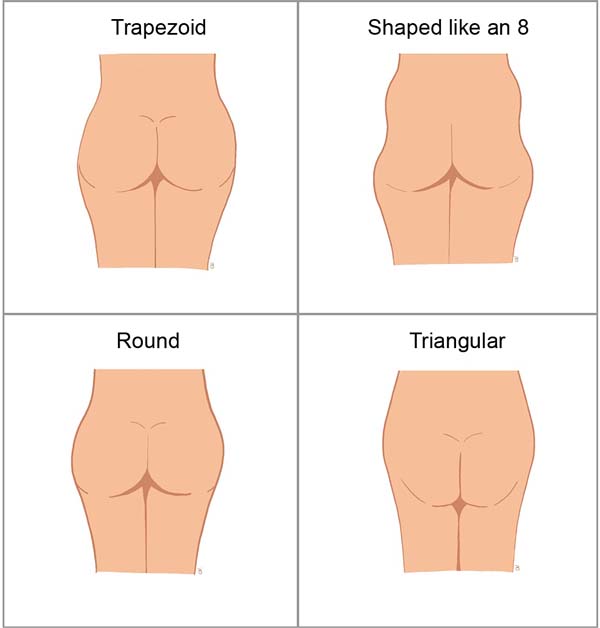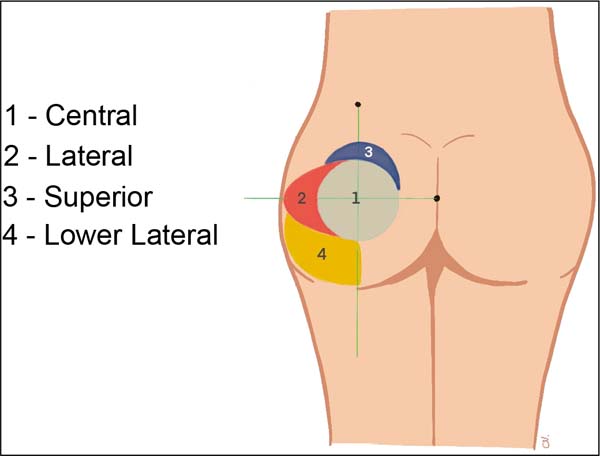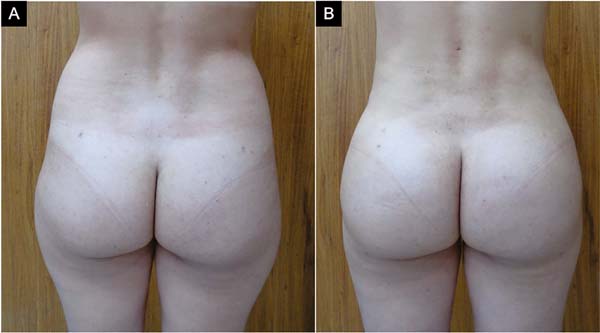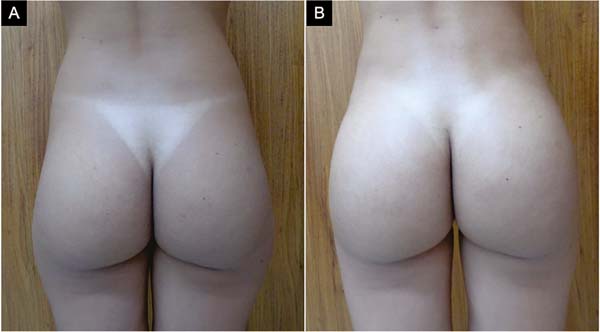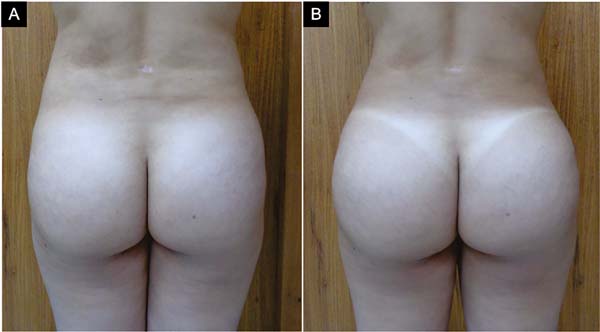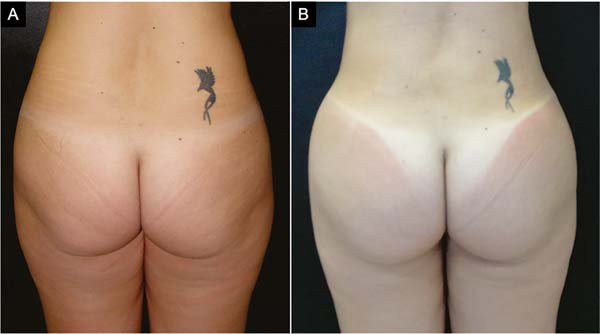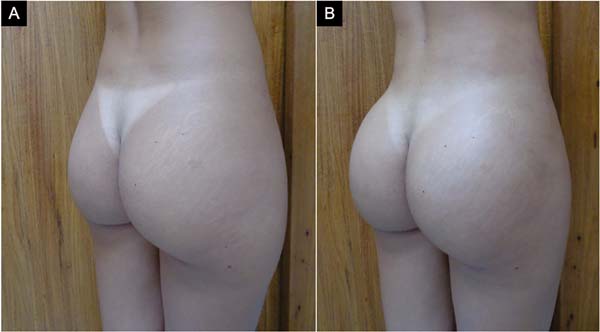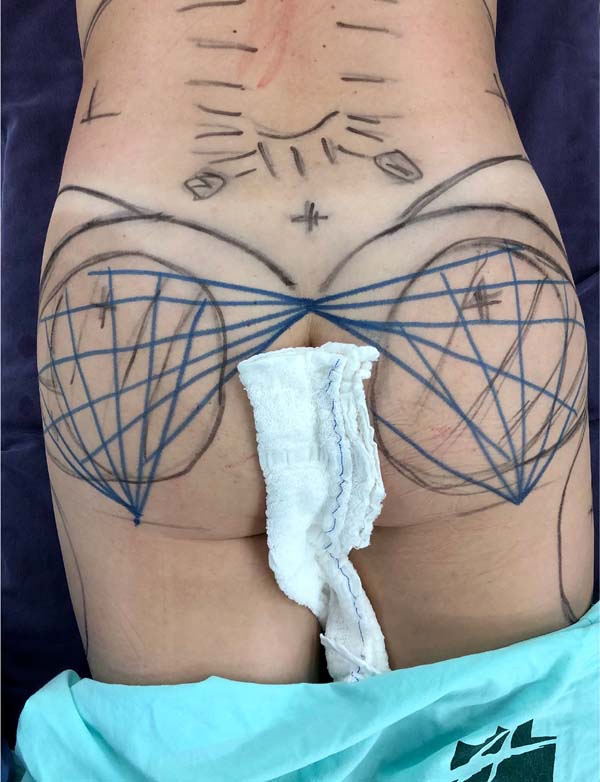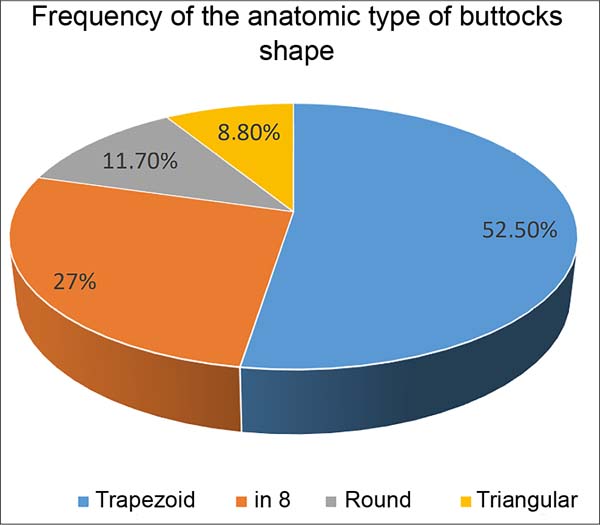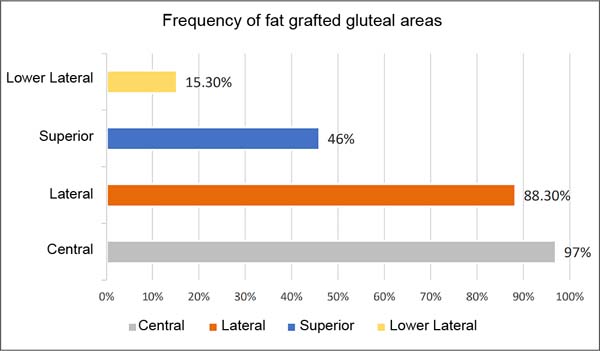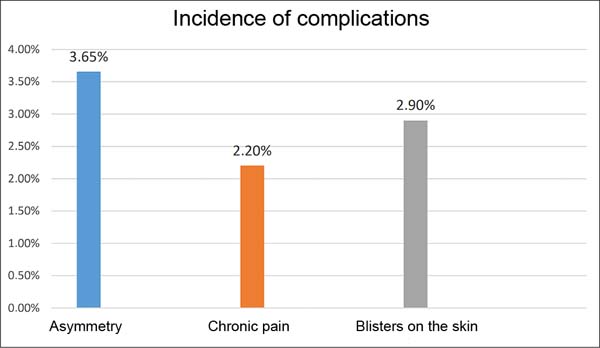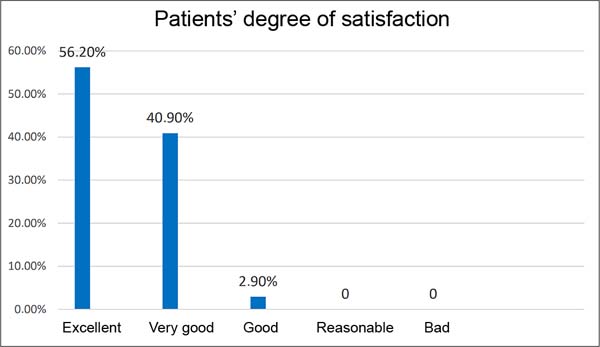INTRODUCTION
Bone structure and the genetic tendency of adipose tissue deposition will define body
shape characteristics, with those with wider hips and greater deposition of fat in
the gluteal-trochanteric region being more cinched.
Aesthetic patterns of female body contour tend to vary over time, following cultural
trends and regional factors, which can be corroborated through sculptures, paintings,
magazines, and social media 1. The waist/hip ratio measurement of close to 0.7 has been considered good for the
female body shape.
Nowadays, the buttocks and breasts are the main prominent regions, especially in Latin
America, where there is a strong media appeal for the ideal gluteal, which explains
the increase in the search for gluteoplasty procedures in Brazil in recent years1,2. According to statistics from The International Society of Plastic Surgery (ISAPS),
in 2013, just under 10,000 gluteoplasty procedures with fat grafting were performed
per year3. This procedure has increased over the years, and in 2018 it reached close to 25,000
procedures per year4.
The desire for a body contour with a small waist, contrasting with the more voluminous
gluteal region, has made many women seek this type of beauty standard5 . Liposuction is essential to reduce the waist and still provides the fat to model
the buttocks. Gluteal fat grafting consists of aspirating fat from different body
regions and inserting it into the buttocks. It is a procedure that uses an autologous,
safe biological product with predictable results6.
Compared to other procedures to add volume to the buttocks, such as silicone implants
and injection of permanent alloplastic materials, such as polymethylmethacrylate,
fat grafting has a lower incidence of complications7,8. Nevertheless, gluteal fat grafting can also present serious complications in the
attempt to inject large volumes due to the possibility of causing fat embolism and
even death9,10. To avoid them, The Aesthetic Surgery Education and Research Foundation (ASERF) emphasizes
some precautions that must be respected, such as: avoiding injecting fat into the
muscle; using more caliber cannulas when injecting, such as the 4mm with only one
hole; direct the cannula to the most superficial tissues and inject the fat with the
cannula in motion11.
Following these guidelines, gluteal fat grafting becomes an important procedure in
the treatment of body contouring, with a low incidence of complications, as evidenced
in a meta-analysis study carried out in 2016 by Alexandra Condé-Green and collaborators,
comprising 4,105 patients from 19 articles selected, which found an incidence of 6.7%
of minor complications and 0.32% of major complications12.
Surgery composed of gluteal augmentation, using fat grafting and silicone gluteal
implants, as proposed by Aslani & Del Vecchio13, is an option that can improve gluteoplasty results and reduce complications, but
studies are still lacking better conclusions.
OBJECTIVE
This article has the general objective of evaluating the results of gluteal fat grafting
and specific objectives of determining the incidence of complications, the average
volume of fat grafted on each gluteal, the anatomical pattern of the glutes, creating
a classification to facilitate the teaching and learning of which areas to be grafted
according to the anatomy of each buttock and the degree of patient satisfaction.
METHODS
This is a prospective study carried out from January 2018 to February 2020, with a
minimum follow-up of 6 months postoperatively. The patients underwent surgery from
January 2018 to August 2019, and the evaluations took place from July 2018 to February
2020. The variables evaluated were age, sex, anatomical classification of the buttocks,
gluteal areas fat grafted, volumes of fat used, patient satisfaction and complications.
Inclusion criteria for the study were patients aged between 18 and 60 years, undergoing
liposuction and fat grafting in the buttocks.
Exclusion criteria for the study were patients who refused to participate in the study
and patients who could not be followed up to the sixth month.
The region’s planning to be fat grafted was programmed according to the anatomical
type of the patient’s buttocks (Chart 1 and Figures 1 to 7), with liposuction always being performed on the flanks. Other areas were liposuctioned
as needed. The division of the gluteal areas to receive the graft was made according
to Figure 2 and mentioned in Chart 1.
Chart 1 - Correlation between the anatomical classification of the buttocks and the areas to
be fat grafted.
| Buttock shape type |
Anatomical feature of the gluteus in the posterior view of the body silhouette |
Areas to be fat grafted |
| Trapezoid |
Two prominent points in the lateral projection, one in the upper portion and one in
the lower portion of the gluteus, without depression in the middle.
|
Area 1- central
Area 2- side
Area 3- upper
|
| Shaped like an 8 |
Two prominent points in the lateral projection, one in the upper portion and one in
the lower portion of the gluteus, with depression in the middle.
|
Area 1- central Area 2- side |
| Round |
Only a prominent point in the lateral projection is in the middle of the gluteus. |
Area 1- central Area 3- superior |
| Triangular |
Only a prominent point in the lateral projection is in the upper portion of the gluteus. |
Area 4- inferolateral |
Chart 1 - Correlation between the anatomical classification of the buttocks and the areas to
be fat grafted.
Figure 1 - Classification of gluteal shape patterns.
Figure 1 - Classification of gluteal shape patterns.
Figure 2 - Fat grafting areas in the gluteus.
Figure 2 - Fat grafting areas in the gluteus.
Figure 3 - A: Representative case of the trapezoid gluteus, preoperatively. B: Postoperative period 6 months after fat grafting in the central, lateral, and superior
areas.
Figure 3 - A: Representative case of the trapezoid gluteus, preoperatively. B: Postoperative period 6 months after fat grafting in the central, lateral, and superior
areas.
Figure 4 - A: Representative case of the 8-shaped gluteus, preoperatively. B: Postoperative period 6 months after fat grafting in the central and lateral areas.
Figure 4 - A: Representative case of the 8-shaped gluteus, preoperatively. B: Postoperative period 6 months after fat grafting in the central and lateral areas.
Figure 5 - A: Representative case of the gluteus teres, preoperatively. B: Postoperative period 6 months after fat grafting in the central and upper areas.
Figure 5 - A: Representative case of the gluteus teres, preoperatively. B: Postoperative period 6 months after fat grafting in the central and upper areas.
Figure 6 - A: Representative case of the triangular gluteus, preoperatively. B: Postoperative period 6 months after fat grafting in the inferolateral area.
Figure 6 - A: Representative case of the triangular gluteus, preoperatively. B: Postoperative period 6 months after fat grafting in the inferolateral area.
Figure 7 - Highlight the accentuation of the curve between the back and the buttocks through
liposuction of the region above the buttocks, associated with fat grafting in the
central and upper areas of the same. A: Preoperative. B: Postoperative period at 6 months.
Figure 7 - Highlight the accentuation of the curve between the back and the buttocks through
liposuction of the region above the buttocks, associated with fat grafting in the
central and upper areas of the same. A: Preoperative. B: Postoperative period at 6 months.
The surgeries were performed in a private hospital on patients of the first author.
The research was approved by the Research Ethics Committee, with a certificate of
presentation of ethical appreciation number 48417821.6.0000.0018 and opinion number
4,877,284. Three patients did not accept participating in the study, and 146 accepted
and signed the Free and Informed Consent Form.
The tumescent technique was used to obtain the fat, infiltrating the area liposuctioned
with saline solution with adrenaline 1:500,000, with a 60ml syringe and a 3mm Klein
cannula. Aspiration was performed with an Allcap® lipoaspirator, the pressure of -600mmHg, an intermediate sterilized bottle to collect
the fat, and cannulas with three aligned holes, 3.5 and 4.0mm in diameter.
Fat preparation was performed by decanting in 60ml syringes for 10 minutes (Figure 8). We do not wash or strain the fat.
Figure 8 - Method of fat preparation by decanting.
Figure 8 - Method of fat preparation by decanting.
The fat injection was via the intergluteal sulcus and subgluteal sulcus using a 4mm
cannula with three aligned holes and a 60ml syringe in retroinjection, with the cannula
in motion, injecting 15 to 20ml per pass of the cannula, in the subcutaneous plane,
starting through the deepest part and then injecting more superficially, trying to
make a fan distribution (Figure 9). In the end, a massage was performed to model and regularize the skin surface.
Figure 9 - Marking of the fat injection technique through the intergluteal sulcus and subgluteal
sulcus, with fan distribution.
Figure 9 - Marking of the fat injection technique through the intergluteal sulcus and subgluteal
sulcus, with fan distribution.
In the postoperative care, antimicrobial prophylaxis was performed with cefazolin,
01g every 8 hours, for 24 hours and azithromycin, 500mg a day, for 5 days. In procedures
with fat grafting not associated with other surgeries, patients were instructed to
remain in the prone position (preferred) for 15 days. In liposculpture combined with
abdominoplasties, mammaplasties and/or nose, the patients were instructed to lie supine
in the postoperative period. In the first two weeks, massage or lymphatic drainage
was not performed in the fat grafted regions.
After the sixth postoperative month, the result evaluation was performed following
the 5-point Likert scale (1=poor, 2=fair, 3=good, 4=very good and 5=excellent).
RESULTS
A total of 146 patients participated in the study, but it was not possible to follow
up until the sixth month in nine cases, and they were excluded. Of the 137 patients
in the final sample group, 132 were women and 5 men. They were aged between 18 and
54 years (mean 34.1 years), and the patients’ body mass index (BMI) ranged from 22.6
to 29.8 kg/m2 (average 27.2Kg/m2);
The predominant anatomical pattern was trapezoid (52.5%), followed by figure-8 (27%),
round (11.7%) and triangular (8.8%) (Figure 10).
Figure 10 - Frequency of the anatomic type of buttocks shape.
Figure 10 - Frequency of the anatomic type of buttocks shape.
The volume of fat injected into the buttocks ranged from 240ml to 1000ml per buttock,
with averages of 510.8ml in the right buttock and 580.5ml in the left buttock. Only
30.65% of the patients had symmetrical buttocks in the preoperative period.
As for the donor areas (in some cases, there was more than one donor area), the waist
(flanks and lumbar region) was used in all 137 patients (100%), the side of the thighs
(culottes) was included in 108 cases (78, 8%) and the inner thighs in 95 of them (69.3%).
The fat grafted areas (in most cases, more than one area was grafted) were: 1- central,
in 133 patients (97%); 2- lateral, in 121 of the cases (88.3%); 3- superior, in 63
patients (46%); and 4- inferolateral, in 21 cases (15.3%) (Figure 11).
Figure 11 - Graph of the frequency of fat grafted gluteal areas.
Figure 11 - Graph of the frequency of fat grafted gluteal areas.
We had 12 (8.75%) minor complications (Figure 12) and no major complications. No fat necrosis, seroma, infection, or fat embolism
was observed.
Figure 12 - Graph of the incidence of complications.
Figure 12 - Graph of the incidence of complications.
The evaluation of satisfaction obtained by patients was described as excellent in
56.2% and very good in 40.9% of cases (Figure 13).
Figure 13 - Graph of patients’ degree of satisfaction with the result.
Figure 13 - Graph of patients’ degree of satisfaction with the result.
DISCUSSION
The first gluteoplasty procedure was published in 1969 by Bartels, in which the author
used breast implants in the gluteus for reconstruction14. With the advancement of liposuction, a new alternative to gluteoplasty emerged,
fat grafting15,16.
Gluteoplasty surgeries have become more frequent over the years due to the demand
for patients who want to increase the gluteal region, thus obtaining a better body
contour12,17. Therefore, gluteal fat grafting has become an increasingly important procedure due
to its great demand and good results without using alloplastic materials12,18.
In the present study, the mean age was 34.1 years, and 96.35% of the patients were
female, following a similar pattern in other studies2,6,19. The predominant buttock shape was the trapezoid, followed by the figure 8.
The volume of fat injected in most patients was different in each buttock, with the
left one receiving more volume, 580.5 ml on average, compared to the average volume
grafted on the right side, which was 510.8 ml. In the studies studied, there were
no differences in fat injections between the sides of the buttocks, and the fat grafted
volumes were like the study by Rosique et al.19, who injected an average of 505 ml in each buttock, as well as in work by Cansancao
et al.,6 in which the average volume injected on each side was 521.1 ml.
However, a survey carried out by the same author with 853 Brazilian plastic surgeons
showed that 75.65% of them usually inject between 200-399 ml per side, and only 16.71%
of them used values of 400-599 ml18.
Infiltration of the donor region using saline with adrenaline, as performed in our
study, is the most used according to the review by Condé-Green et al.12, followed by Klein and Ringer lactate solutions with adrenaline. The present study
obtained fat with 3.5- and 4.0-mm cannulas through liposuction devices12. The research by Cansancao et al. with Brazilian plastic surgeons had similar results,
showing a preference for using liposuction devices and a 4 mm cannula18.
Fat preparation is debatable in the literature, with several techniques reported15,20,21. In this study, we prepared the fat using the decanting technique, which is the most
used in several scientific articles, including research with plastic surgeons in Brazil,
with fat washing being the second most used technique18. In the review by Condé-Green et al.,12, the decantation was also the most used, followed by centrifugation in second place.
The donor regions of the patients in our study were varied. There was a need for more
than one donor area in several patients, and the waist and the lateral region of the
thighs were the most used, in agreement with the literature19,22.
Regarding the fat injection planes, we exclusively used the subcutaneous plane, which,
after the task force carried out by the Aesthetic Surgery Education and Research Foundation, has been the most used because it is the safest6,11,18.
Fat grafting was performed using 60ml syringes and 4mm cannulas, with three holes
aligned at the tip. According to Condé-Green et al.12, only 15% used 4mm cannula, 54.5% of these procedures were performed with 60ml syringes,
and only three articles reported the use of cannula with three holes; these data partially
agree with our work. We inject 15 to 20 ml of fat for each cannula pass, agreeing
with six articles analyzed by Condé-Green et al.12, who reported the injection varying between 0.3 and 20 ml for each cannula passage.
The most grafted areas were: area 1, central, in 97%, is the main one for global gluteal
augmentation and to give more projection (Figure 7); area 2, lateral, in 88.3%, serves for modeling, filling the depression at Mendieta’s
point C22; area 3, superior, in 46%, serves to stretch the short glutes and when you want a
more accentuated curve between the back and the gluteus (Figure 7); area 4, inferolateral, in 15.3%, it is not very common to be grafted, and its use
usually occurs in the triangular glutes, to improve their shape, although, in these
cases, the expansion capacity of area 4 is more limited, causing a correction, sometimes
smaller than desired (Figure 6).
In the present study, only mild complications were observed, such as asymmetry, which
affected five patients (3.65%), chronic pain (more than 30 days) in three cases (2.2%)
and superficial epidermolysis blisters in four cases. (2.9%). We did not detect any
seroma collection, unlike what we found in the articles by Condé-Green et al. and
Rosique et al. Its occurrence ranged from 2.4 to 4.7% and is one of the most reported
complications in the literature12,19. We emphasize that fat grafting was performed only in the subcutaneous plane, and
there were no serious complications such as fat embolism and death. According to the
researched literature, these serious complications were more frequent when the graft
was performed in the muscular plane9,12. Therefore, we emphasize the importance of the fat graft being placed only in the
subcutaneous plane.
In the cases of asymmetries, we emphasize that they already existed in the preoperative
period and were not completely corrected with fat grafting. However, they obtained
significant improvement. There was no need for additional surgery since the patients
were satisfied with the result. In cases of blister formation, these were treated
by placing a semipermeable transparent adhesive film dressing (Tegaderm®), which was only removed after absorbing the liquid from the blister. Initially,
these areas evolved with dyschromia but responded satisfactorily to the treatment
prescribed by the dermatologist. The two cases of chronic pain improved with physical
therapy (mobilization and carboxytherapy) and resolved within 4 months.
Regarding patient satisfaction, 97.1% of the result was considered excellent or very
good, like the work by Rosique et al.19, whose excellent or very good result was observed in 97% of the cases, as well as
in the survey carried out by Condé-Green et al.12, in which, in the studies in which this was evaluated, most of the results were also
considered excellent or good.
CONCLUSION
Gluteoplasty with fat grafting is a procedure that provides good results, considered
“excellent” or “very good” in 97.1% of cases, with a low incidence of complications,
with 8.75% of minor complications, and is more sought after by women in their 30s.
at 40 years old. The trapezoid shape of the gluteus is the most frequent anatomical
pattern, corresponding to 52.5%, and the central and lateral areas are the most fat
grafted, 97% and 88.3%, respectively. The average volume of fat placed in each buttock
is between 500 and 600ml, with 580.5ml on the left side and 510.8ml on the right.
A classification of the buttocks and standardization of graft areas were defined to
help teach this procedure.
REFERENCES
1. de la Peña JA, Rubio OV, Cano JP, Cedillo MC, Garcés MT. History of gluteal augmentation.
Clin Plast Surg. 2006;33(3):307-19. PMID: 16818090 DOI: https://doi.org/10.1016/j.cps.2006.04.003
2. Lima DA, Minakami DA, Pereira LC, Grando MC, Cruz RS, Braga AR, et al. Gluteoplastia
de aumento: a importância do ensino na formação atual do residente frente à demanda
crescente. Rev Bras Cir Plást. 2011;26(1):127-33. DOI: https://doi.org/10.1590/S1983-51752011000100023
3. American Society of Plastic Surgeons. [Internet]. 2013 plastic surgery statistics
report. [acesso 2021 Mar 25]. Disponível em: https://www.plasticsurgery.org/documents/News/Statistics/2013/plastic-surgery-statistics-full-report-2013.pdf
4. American Society of Plastic Surgeons. [Internet]. 2018 plastic surgery statistics
report. [acesso 2021 Mar 25]. Disponível em: https://www.plasticsurgery.org/documents/News/Statistics/2018/plastic-surgery-statistics-full-report-2018.pdf
5. Singh D. Universal allure of the hourglass figure: an evolutionary theory of female
physical attractiveness. Clin Plast Surg. 2006;33(3):359-70. DOI: https://doi.org/10.1016/j.cps.2006.05.007
6. Cansancao AL, Condé-Green A, David JA, Vidigal RA. Subcutaneous-Only Gluteal Fat Grafting:
A Prospective Study of the Long-Term Results with Ultrasound Analysis. Plast Reconstr
Surg. 2019;143(2):447-51. DOI: https://doi.org/10.1097/prs.0000000000005203
7. Mofid MM, Gonzalez R, de la Peña JA, Mendieta CG, Senderoff DM, Jorjani S. Buttock
augmentation with silicone implants: a multicenter survey review of 2226 patients.
Plast Reconstr Surg. 2013;131(4):897-901. DOI: 10.1097/PRS.0b013e3182818ec0
8. Kurimori KT, Mendes M, Milcheski DA, Monteiro Junior AA, Gemperli R. Complicação grave
do uso irregular do PMMA: relato de caso e a situação brasileira atual. Rev Bras Cir
Plást. 2019;34(1):156-62. DOI: 10.5935/2177-1235.2019RBCP0025
9. Cárdenas-Camarena L, Bayter JE, Aguirre-Serrano H, CuencaPardo J. Deaths Caused by
Gluteal Lipoinjection: What Are We Doing Wrong? Plast Reconstr Surg. 2015;136(1):58-66.
DOI: https://doi.org/10.1097/prs.0000000000001364
10. Toledo LS. Gluteal augmentation with fat grafting: the Brazilian buttock technique:
30 years’ experience. Clin Plast Surg. 2015;42(2):253-61. DOI: https://doi.org/10.1016/j.cps.2014.12.004
11. Mofid MM, Teitelbaum S, Suissa D, Ramirez-Montañana A, Astarita DC, Mendieta C, et
al. Report on Mortality from Gluteal Fat Grafting: Recommendations from the ASERF
Task Force. Aesthet Surg J. 2017;37(7):796-806. DOI: https://doi.org/10.1093/asj/sjx004
12. Condé-Green A, Kotamarti V, Nini KT, Wey PD, Ahuja NK, Granick MS, et al. Fat Grafting
for Gluteal Augmentation: A Systematic Review of the Literature and Meta- Analysis.
Plast Reconstr Surg. 2016;138(3):437e-46e. DOI: https://doi.org/10.1097/prs.0000000000002435
13. Aslani A, Del Vecchio DA. Composite Buttock Augmentation: The Next Frontier in Gluteal
Aesthetic Surgery. Plast Reconstr Surg. 2019;144(6):1312-21. DOI: 10.1097/PRS.0000000000006244
14. Bartels RJ, O’Malley JE, Douglas WM, Wilson RG. An unusual use of the Cronin breast
prosthesis. Plast Reconstr Surg. 1969;44(5):500. PMID: 5345491 DOI: https://doi.org/10.1097/00006534-196944050-00023
15. Oliveira Neto FV. Enxerto de gordura humana em ratos: estudo comparativo de diferentes
preparos da gordura. Rev Bras Cir Plást. 2011;26(3 Supl.1):5.
16. Illouz YG. Body contouring by lipolysis: a 5-year experience with over 3000 cases.
Plast Reconstr Surg. 1983;72(5):591-7. DOI: https://doi.org/10.1097/00006534-198311000-00001
17. Rodrigues Neto JN, Guimarães GS, Benedik Neto A, Cammarota MC, Daher JC. Prótese glútea:
o uso da lipoaspiração na melhora dos resultados. Rev Bras Cir Plást. 2010;25(2):344-8.
18. Cansancao AL, Condé-Green A, Rosique RG, Rosique MJ, Cervantes A. “Brazilian Butt
Lift” Performed by Board-Certified Brazilian Plastic Surgeons: Reports of an Expert
Opinion Survey. Plast Reconstr Surg. 2019;144(3):601-9. PMID: 31461012 DOI: https://doi.org/10.1097/PRS.0000000000006020
19. Rosique RG, Rosique MJF, De Moraes C. Gluteoplasty with autologous fat tissue: experience
with 106 consecutive cases. Plast Reconstr Surg. 2015;135(5):1381-9. DOI: https://doi.org/10.1097/prs.0000000000001167
20. Coleman SR. Structural fat grafting: more than a permanent filler. Plast Reconstr
Surg. 2006;118(3 Suppl):108S-20S. DOI: 10.1097/01.prs.0000234610.81672.e7
21. Roberts TL 3rd, Toledo LS, Badin AZ. Augmentation of the buttocks by micro fat grafting.
Aesthet Surg J. 2001;21(4):311-9. DOI: https://doi.org/10.1067/maj.2001.117926
22. Mendieta C, Stuzin JM. Gluteal Augmentation and Enhancement of the Female Silhouette:
Analysis and Technique. Plast Reconstr Surg. 2018;141(2):306-11. DOI: 10.1097/PRS.0000000000004094
1. Universidade Federal do Pará, Belém, PA, Brazil
2. Hospital Amazônia, Belém, PA, Brazil
3. Spani Vendramin Clinic, Plastic Surgery, Belém, PA, Brazil
Corresponding author: Fabiel Spani Vendramin Rua Municipalidade, no 985, sala 2112, Umarizal, Belém, PA, Brazil, Zip Code: 66050-350,
E-mail: drfabiel@gmail.com
Article received: April 12, 2021.
Article accepted: October 15, 2021.
Conflicts of interest: none.




